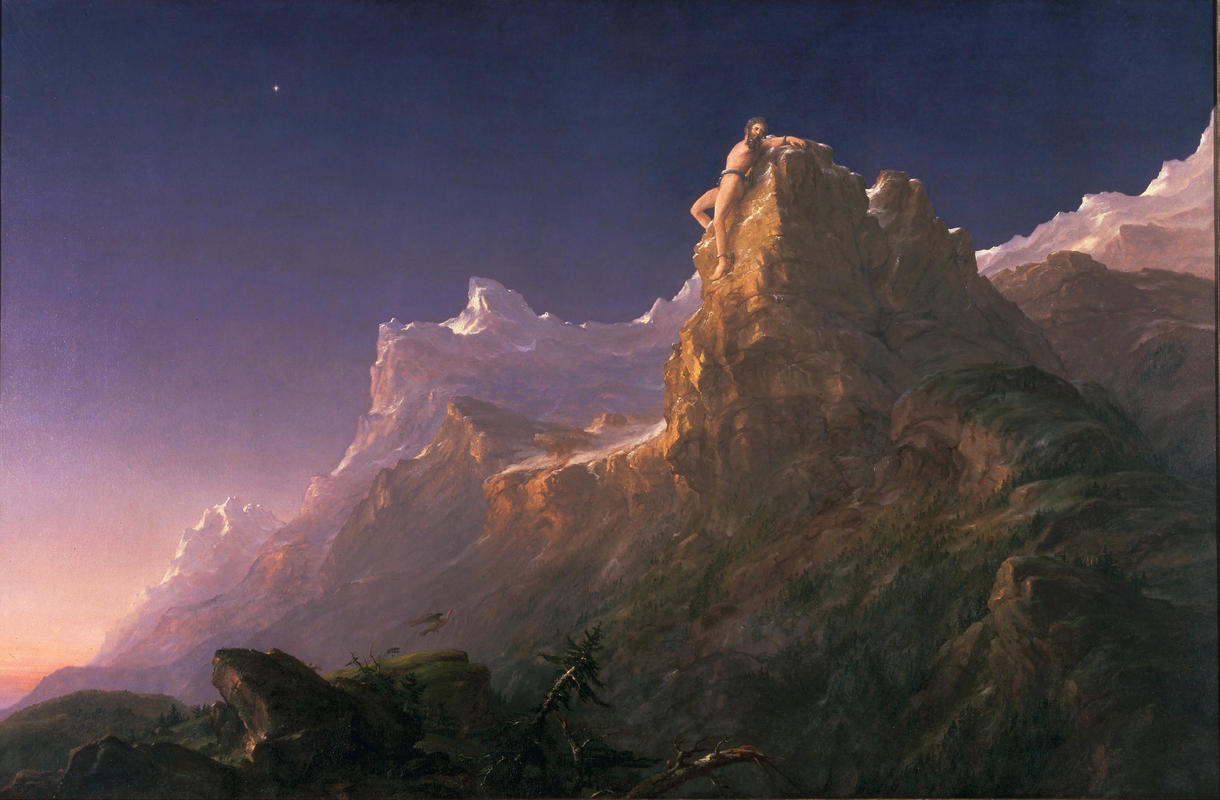More about Prometheus Bound

Sr. Contributor
There’s few Greek myths as universally recognizable as Prometheus’ near endless suffering.
Even if you’re not a Greek myth fan, you’ve likely heard the story about an eagle eating a man’s liver every day because said tortured sufferer gave the world fire. Here, Thomas Cole’s interpretation focuses on reproducing his imprisonment on such a grand scale that the chained Titan looks like an ordinary man.
The piece is six feet by eight feet, and was most likely intended for public display and not done on commission. So, Cole had rather titanic ambitions for this work, having made it so large with no guarantee it would be purchased. Safe to say as we are discussing it now, it worked out well. Cole’s main source for this piece was the play of the same name, Prometheus Bound by Aeschlyus. He felt so inspired by the Titan’s story that he even wrote a poem called Prometheus to accompany his painting.
It is a beautiful landscape, but after one day of imprisonment the cold and lonely scenery would probably get old, whether or not an eagle swung by. Note the single star in Cole’s painting, which is Zeus keeping an eye on Prometheus. Mornings are especially lonely for our Titan since his prison warden is the only sign of a living being in sight.
Now, if you’re unfamiliar with the details you might be wondering how did Prometheus get unbound? Or is that eagle still torturing him somewhere? Well, the play ends with him suffering in agony, but does also relay that he will be free one day. Prometheus had the gift of prophecy, so he both foresaw his punishment before stealing fire from Olympus and his eventual freedom.
While there’s no Greek myth “canon,” it is an expanded universe vaster than Marvel and Prometheus’ story overlaps with several other tales, most notably Jupiter and Io. Io was a beautiful princess that Zeus (aka Jupiter) turned into a cow to hide his affair/assault from Hera. Hera, being not an idiot, saw through the ruse and sent a gadfly to torture Io and chase her around the world. One such stop on her terrible world tour was the cliff to which Prometheus was chained. In the play, he talks with Io, asking if she wants to know her future. Seeing Io is good news for Prometheus because it means he only has several generations of suffering left, because it is a descendent of her line that rescues him. He tries to tell Io to take heart, saying she’ll become human again and, while she’s fated to have a kid by Zeus, she can at least find comfort in the fact that his reign in Olympus won’t be eternal.
The rescuer Prometheus has foreseen is none other than Hercules who, depending on the version of the story, doesn’t really come to rescue him but just asks him for directions. He then kills the eagle and sets Prometheus free to return the favor. Now freed, however unintentionally, Prometheus knows Zeus isn’t done with him yet. He knows he has to offer a bargaining chip to keep his freedom.
This leads to the story of Jupiter and Thetis. To keep his freedom, Prometheus tells Zeus not to marry or hook up with the goddess Thetis because she is fated to bear a child that will surpass his father. Now, if he hadn’t told him this then Zeus’s reign would have indeed ended thanks to said unborn god-child. By revealing it, he got to stop suffering a horrible torment, but kept the psychopath in power and ended up lying to Io. As a result of this, Thetis was basically deemed untouchable among the gods since they’re all arrogant and don’t want a child to surpass them. So, Zeus arranges/forces Thetis to marry Peleus, the mortal king of Phthia. Together they have Achilles, and the whole saga sets the stage for Homer's epic poem Iliad.
I’m not sure where Prometheus ends up after that, but I hope it's on a beach somewhere getting some well-deserved R&R. Or even better, plotting Zeus’s downfall in a story that didn’t survive to our day but we can pretend existed.
Sources
- Aeschylus. Prometheus Bound. Portland: Mint Editions, 2020.
- Apollodorus, R. Scott Smith, Stephen Trzaskoma, and C. Julius. Hyginus. Apollodorus Library and Hyginus Fabulae: Two Handbooks of Greek Mythology. Indianapolis: Hackett Pub., 2007.
- Junker, Patricia. "Thomas Cole's "Prometheus Bound:" An Allegory for the 1840s." American Art Journal 31, no. 1/2 (2000): 33-55. Accessed August 31, 2021. doi:10.2307/1594625.
- Luhrs, Kathleen, John Caldwell, and Oswaldo Rodriguez Roque. American Paintings in the Metropolitan Museum of Art. New York: Metropolitan Museum of Art, 1994.
- Salisbury, Joyce E. Encyclopedia of Women in the Ancient World. Santa Barbara, CA: ABC-CLIO, 2010.
Featured Content
Here is what Wikipedia says about Prometheus Bound (Thomas Cole)

Prometheus Bound is an 1847 oil painting by American artist Thomas Cole. Prometheus Bound is one of Cole's largest paintings, and like his other major works of the 1840s it was not the result of a commission. It draws from the ancient Greek tragedy Prometheus Bound by Aeschylus. In the painting, Prometheus is chained to a rock on Mount Caucasus in Scythia. Zeus has punished him for endowing humans with life, knowledge, and specifically for giving humans fire. Each day a raptor comes to feed on Prometheus's liver, which regrows between visits, making Zeus's punishment even more cruel.
The allegorical painting is among Cole's last works, but Cole never commented on the theme of the work. Art historians have tentatively linked the bondage of Prometheus to abolitionist sentiment by reviewing the presentation of the mythical figure in contemporaneous literature. Cole sent it to London for an 1847 exhibit and competition to decorate the Houses of Parliament, and the painting was still in London when he died. It thus received little exhibition in the United States in the 1840s, making its reception (and its theme) difficult to judge.
Check out the full Wikipedia article about Prometheus Bound (Thomas Cole)













